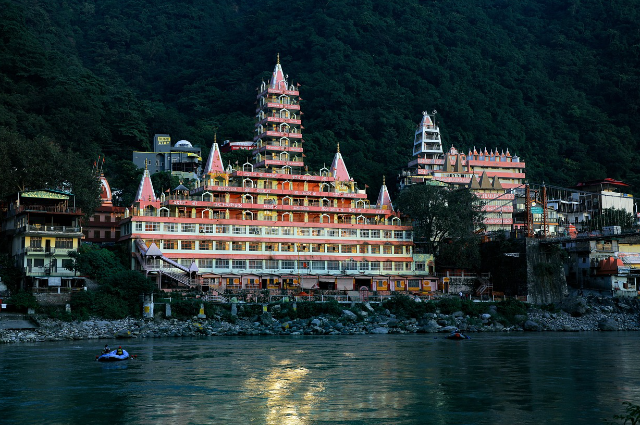
There was a time when the name Kedarnath brought silence into a conversation. It wasn’t just a destination, it was an emotion. It carried a certain weight, a sense of purity that couldn't be described in mere words. People should prepare for months, mentally and physically, before visiting such places. But today, scroll through Instagram or any travel vlog, and you’ll see people doing reels, posing with sunglasses, shouting chants for the camera, all in front of temples that were once considered too sacred to even photograph. What’s happening? Why does it feel like temples have become new vacation spots for us?
In recent years, India has seen a massive rise in spiritual tourism. That in itself isn’t a problem. It’s actually a good thing when young people try to reconnect with their roots, seek peace in the mountains, or find themselves in silence. But the problem begins when intentions change. Visiting a temple should ideally be about devotion, surrender, and spiritual experience and not about content creation. For example, Kedarnath, which once echoed with mantras and quiet chants, now echoes with camera clicks and background music of trending songs. People hike all the way just to capture the perfect sunrise shot with the temple in the background. The journey to God has become a journey of views. It’s not just Kedarnath. From Banaras ghats to Pushkar, from Amarnath to Rishikesh, these places are slowly losing their deeper spiritual identity. Young travellers often come with ring lights and selfie sticks, but leave without bowing their heads in genuine prayer.
Many young Indians today claim to be spiritual or religious. And maybe some of them are. But for a growing section, religion has become a trend, a filter to use on social media. Wearing rudraksha beads, chanting “Har Har Mahadev,” or getting Trishul tattoos has become part of the aesthetic. And there’s nothing wrong with expressing your beliefs. But when your belief system changes based on what’s viral this week, it no longer remains spirituality; it becomes performance. In fact, some influencers today have made entire careers out of spiritual tourism. Their content may have good intentions, but it also encourages a culture where sacredness becomes a backdrop, not the main theme.
Spirituality isn’t loud. It’s not meant for the camera. It’s something you feel in silence, in surrender. But today, it seems that silence is being replaced by speakers, chants replaced by trending audios. Let’s take Kedarnath as a symbol. This temple, buried under years of snow and then resurrected after a devastating flood, stands not just as a place of worship but as a reminder of survival, faith, and resilience. Its story is emotional, heavy, and holy. But today, many people go there dressed like they’re heading to a music festival. They dance, shout slogans not in reverence but in hype, and even record videos with outdated captions. In all this noise, the temple’s silence is lost.
When people dance in front of temples, do photo shoots on the stairs of ghats, or casually smoke near shrines, they’re not just being disrespectful, they’re stripping the place of its soul. Some priests have even spoken up, saying they feel helpless. Rules are posted, but not followed. Warnings are given, but ignored. Because the idea of a “spiritual trip” today is more about the trip and less about the spirit. This behaviour isn’t random. It’s a result of the times we live in. Today’s generation grew up with Instagram, YouTube, and constant comparisons. Everything is about showing, not just doing. So naturally, even something as personal as prayer becomes a post. The younger generation wants connection, but ends up copying others. They want peace, but end up in chaos. They want God, but don’t realise God isn't found in a reel, He’s found in the stillness you don’t post.
This absurdity should change. It’s okay to travel to religious places. It’s beautiful that people are curious and drawn to these places. But there needs to be a shift in mindset.
Ask yourself why you’re going? Is it to feel closer to something divine, or just to click pictures?
Respect the space. Temples, ghats, and holy spots aren’t your photo studio. Keep the camera aside for a few minutes. Observe. Feel. Listen.
Don’t pretend to be spiritual. If you're not feeling it, don’t fake it. Real belief isn’t about shouting chants, it’s about understanding them.
Spread the message. If you’re an influencer or content creator, use your platform to also remind people about respect and intention.
We must remember that India’s spiritual richness isn’t just about locations. It’s about the energy, the emotion, the connection to something beyond ourselves. And once that is lost, even the most beautiful temples will just become tourist buildings.
This realisation hits when it feels closer to you. A friend of mine visited Kedarnath last year. He told me how he had planned everything, outfits, reels, poses, and captions. But something changed when he actually reached the temple. He saw an old man, almost 80, who was walking the entire path barefoot. The man had no phone, no camera, just tears in his eyes and folded hands. The old man had the realisation of what visiting such a sacred place means. “My whole trip changed after that,” my friend admitted. “I stopped filming. I just sat in silence for hours. That was a real experience.” And maybe that’s what the youth need, not judgment, but reminders. Not restrictions, but reflection.
It’s time we, the young generation of India, rethink what faith means. It doesn’t lie in filters, in trends, or in how loudly we chant. It lies in how quietly we connect. Temples like Kedarnath aren’t vacations, they’re invitations. Not to party, but to pause. Let’s not turn our most sacred spaces into casual backdrops. Let’s not lose the depth in trying to follow a trend. Because if we keep treating holy places like holiday spots, one day, there’ll be nothing holy left to visit.
